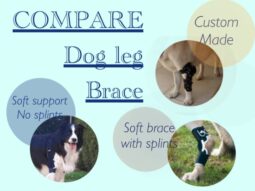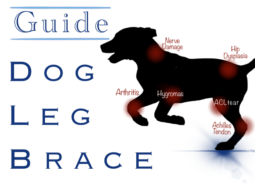This is a guide for pet owners to understand dog leg brace. What brace to choose for your pet conditions? Arthritis, ligaments injury, tendon tear, joint instability, bone injuries, there are so many conditions and pathologies. Let us dive into the list and learn about their advantages for each pathology.
- Senior dogs with ARTHRITIS benefit from leg support.
- Understand dog leg brace for canine LIGAMENTS and TENDONS tears (ACL).
- Advantages of dog leg brace with JOINT INSTABILITY (hip dysplasia).
- Learn more about dog splints for BROKEN LEGS.
- Protective support for HYGROMAS and WOUNDS on dogs' leg.
- Understand dog leg brace as an ALTERNATIVE TO SURGERY.
- An insight of dog leg brace POST - SURGERY.
- Dog leg support for NERVE DAMAGE.
1 - Senior dogs with ARTHRITIS benefit from leg support.
Senior pets with arthritis greatly benefit from leg brace wrap around their joints. It keeps them warm and helps blood flow running. It supports the joint at the end of the range of motion where it hurts. The type of fabric of the leg brace matters. Of course, it should be comfortable but not stretchable. Our socks are stretchable, it keeps us warm but gives no support to arthritic joints. Similarly, for real joint support and compression, the cuff of the wrap should not overlap.
2 - Understand dog leg brace for canine LIGAMENTS and TENDONS tears (ACL)
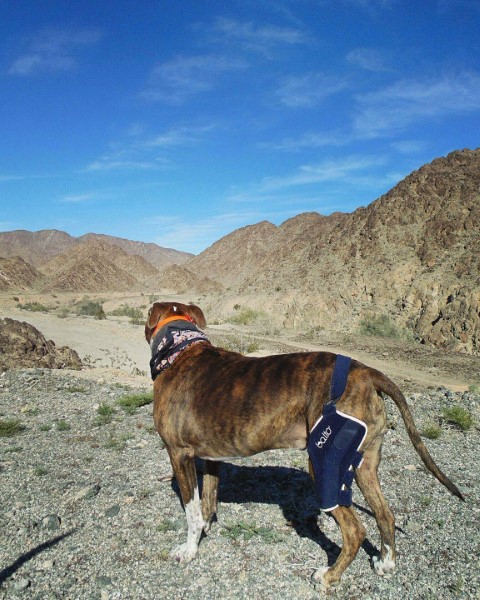
KNEE BRACE FOR CANINE RUPTURE ANTERIOR CRUCIATE LIGAMENT (ACL tear)
This degenerative condition on dog knees is very common. As a result, the dog knee joint becomes unstable. Treatment options include different types of surgery or stabilization with an orthopedic knee brace for dogs. Generally speaking stifle brace for dog cruciate injury includes 3 main types. The custom made with a hard shell, the soft braces with no rigidity, and soft braces with rigid splints. Compare all 3 types of brace
Many factors are involved to decide if a brace is suitable and which one, the level of dog activity, age, presence of arthritis in the knee joint, weight.
HOCK BRACE FOR DOG ACHILLES TENDON RUPTURE
The Achilles tendon partial or total tear is difficult to heal because of the localization of the injury. It is important to realize that the ankle of a dog is designed to hold huge forces. Consequently, whichever treatment option your vet advice for your dog, a dog hock support is certainly strongly recommended. The brace does not need to be hinged but its rigidity will be key to hold the hock joint in place during the recovery even post-surgery.
CARPAL BRACE FOR DOG DIGITAL TENDON INJURY and HYPEREXTENSION OF THE WRIST AND ANKLE
Similarly, tendon and ligament injuries in a dog foot equally benefit from a dog leg support while healing. The recovery period is usually long and a good quality carpal and tarsal dog brace should be able to adapt to 2 main factors. The first factor is its ability to exhibit different degrees of rigidity. Your dog will need stronger support at the beginning of the recovery than a few months down the track. The second factor is its ability to support all the possible injured site (dorsally, medially, laterally...)
3 - Advantages of dog leg brace with JOINT INSTABILITY (hip dysplasia)
DOG LEG BRACE FOR HIP DYSPLASIA AND ELBOW DYSPLASIA
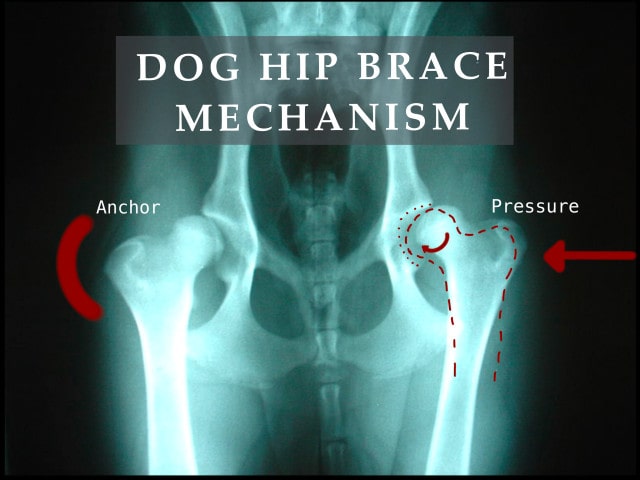
With genetic and nutritional contributing factors, both hip and elbow dysplasia lead to painful and arthritic joints.
A dog hip brace that stabilizes the joint and put pressure on the femoral head is really helpful. In order to achieve the alignment of the femoral head, the brace structure must have an anchor to hold the hip compression. Some hip braces achieve that better than others.
PARTIAL LIGAMENTS INJURY
Many other joint instabilities can occur following trauma. Understanding dog leg braces for each condition such as carpal instability in the wrist, tarsal instability in the hock, or Medial shoulder instability MSI in the shoulder can be tricky. For any joint instability, an efficient leg brace stops or impairs the abnormal joint motion during the recovery period. The structure of the brace and fabric makes a big difference to achieve this goal.
4 - Learn more about dog splints for BROKEN LEGS
Canine bone fracture
After a bone fracture, your dog will undergo a surgery or a cast. A dog leg brace is useful post surgery if your dog is overactive and the veterinarian is concern about its level of activity could damage the surgery. Casts on a dog are challenging. The sedation required to change it, the pressure sores, not to wet it, and not to mention the high risk of breaking the leg again after the cast removal. A rigid dog leg brace can replace a cast more conveniently with the advantage of been used progressively less and less as the bone is healing.
Dog bone cancer Osteosarcoma
Similarly, a rigid dog leg support can protect a weak bone nut just after a fracture but also bone cancer such as osteosarcoma.
DEVIATION VALGUS/VARUS
Growing puppies with valgus and varus deviations are common. It can be addressed with a leg brace. The level of rigidity of the brace matters. The type of malformations as well. When the deviation is fixed, a custom made brace will be more appropriated.
5 - Protective support for HYGROMAS and WOUNDS on dogs' leg
DOG ELBOW HYGROMAS AND SORES
Canine elbows develop hygromas because it is exposed on a hard surface on the ground when lying down. The heavier the dog the more likely to occurs. Unlike any other leg brace, this brace focus on been comfortable at resting time not for walks. The padding is the key element for success.
The fitting is another key factor as the elbow joint is a difficult location to keep a bandage or brace on a dog. Some veterinarian will use leg braces instead of bandages to protect stitches, wounds or lick granuloma.
6 - Understand dog leg brace as an ALTERNATIVE TO SURGERY
ARTHRODESIS - JOINT FUSION
Hock and wrist joints are sometimes beyond repair and carpal or tarsal fusion is the best solution. Alternative to arthrodesis surgery is a carpal or tarsal brace. Again, a key factor is the level of rigidity.
CANINE RUPTURE ANTERIOR CRUCIATE LIGAMENT (ACL. CCL)
For a cruciate injury, the choice between surgical treatment or conservative treatment with a dog knee brace does not stop there. The huge variety of dog knee brace and their efficacy makes it very difficult to decide. Of course, understanding the mechanism of each brand/type of dog knee brace will allow you to be more in control of your choice. It also starts with knowing the other factors specific to your dog, for example, its level of activity, its age, the presence of arthritis or other pathology.
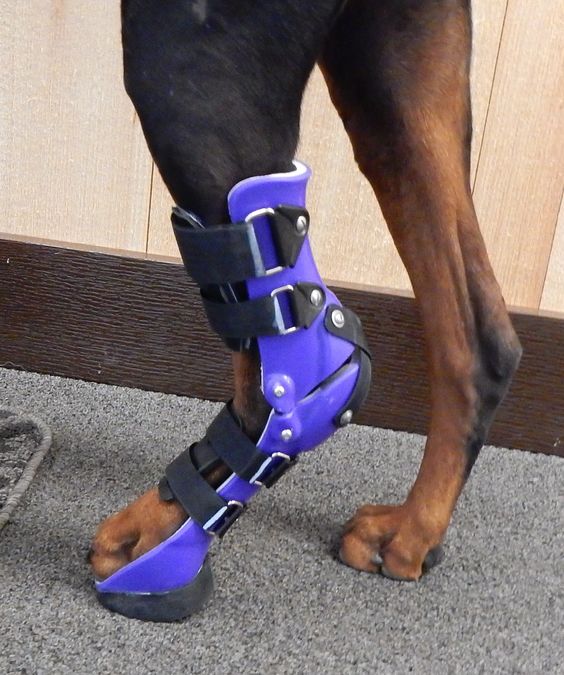
7 - An insight of dog leg brace POST SURGERY
WHEN THE DOG IS OVERACTIVE - TO PROTECT THE SURGERY SITE
It must be remembered that most of the time it is recommended to avoid bracing post-surgery. To prevent ankylosis, the joint should be gently mobilized in a passive range of motion as soon as possible. However, some exceptions occur.
Some of the common situations when a dog leg brace is recommended post-surgery are:
- Post knee surgery (ACL - Patella) to prevent seroma formation with overactive dogs.
- When the goal is to stop the joint motion. It is necessary after hock or wrist fusion arthrodesis surgery
- To hold or replace slipping bandages post-surgery. For examples after surgical reduction of elbow, shoulder, or hip dislocation.
- As a protection for the suture line (stitches) post elbow, hock, or shoulder surgery. These areas are prone to breakdown due to the movement of the suture line when the dog is walking. Therefore, a leg brace to impair the joint motion will protect the suture line while healing.
- To maintain joint compression and help to decrease swelling and pain post arthroscopy. Commonly performed on dog shoulders or elbows (OCD, dysplasia)
8 - Dog leg support for NERVE DAMAGE
KNUCKLING TOES - DRAGGING PAWS
Many factors interfere with the success of a leg brace for toes up. First, the natural angle of the wrist compares to the hock is different so a brace in the front leg and back leg should also be different. The brace should include all the joints that are not functional. For example, the elbow joint must be functional if you are using a carpal brace otherwise your dog will just drag the brace as well.
DOG NECK DISORDERS
Dog neck braces are useful for many reasons. For example, to relax neck muscle (Woobler disease), to impair a specific neck direction (vestibular disease) and, to support (IVDD disc disease), and help with pain control. An adaptable neck brace should be asymmetrical to choose the direction of the neck that is impaired.
DOG PARALYSIS
Dog carrier and harness types proliferate as much as dog knee braces types. Again, details about your specific dog issues should direct your choice. The dog conformation, strength left in the front or back legs, expectation to recovery long term are only a few of them.

